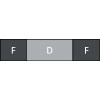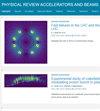Analysis of single particle and collective beam effects in high intensity beams in a periodic quadrupole channel
IF 1.8
3区 物理与天体物理
Q3 PHYSICS, NUCLEAR
Physical Review Accelerators and Beams
Pub Date : 2024-03-19
DOI:10.1103/physrevaccelbeams.27.034201
引用次数: 0
Abstract
In high intensity proton accelerators, there are two main mechanisms that can cause beam degradation: incoherent and coherent effects due to nonlinear space charge forces. The incoherent effects represent the single particle dynamics while the coherent effects represent the collective response of the beam. Of particular interest is the region above a zero current phase advance () of 90° where the (coherent) second-order envelope instability and the (incoherent) fourth-order particle resonance are seen to lead to emittance growth. Large emittance growth is also seen below the envelope instability region as the full current beam phase advance () decreases. In the present study, we have studied the nonlinear effects in a high intensity beam propagating through a focusing-defocusing (FD) quadrupole channel for greater than 90°, both analytically, by studying the solutions of Kapchinsky-Vladimirsky (KV) equation and the particle core model, and through detailed particle-in-cell (PIC) simulations using the tracewin code. The KV envelope equation gives the collective response of the beam while the particle core model gives the contribution of the single particle effects. With pic simulations, which resemble the behavior of the real beams more closely as compared to envelope calculations or the particle core model, it is possible to study the evolution of the beam in a self-consistent manner. Our studies show, that it is possible to identify the specific process responsible for beam degradation in high intensity beams. It is also possible to identify which process dominates under different conditions. We further show that the width of the emittance increase stop band calculated from PIC simulations is wider than that calculated by the envelope equations and that the width depends on the length of the channel being studied.

分析周期性四极通道中高强度光束的单粒子和集束效应
在高强度质子加速器中,有两种主要机制可导致光束衰减:非线性空间电荷力导致的非相干效应和相干效应。非相干效应代表单粒子动力学,而相干效应则代表光束的集体响应。尤其令人感兴趣的是 90° 的零电流相位超前(σ0)以上区域,在该区域,(相干)二阶包络不稳定性和(非相干)四阶粒子共振会导致幅射增长。在包络不稳定性区域下方,随着全电流光束相位提前量 (σ) 的减小,也会出现较大的幅射增长。在本研究中,我们通过研究 Kapchinsky-Vladimirsky (KV) 方程和粒子核心模型的解,以及使用 tracewin 代码进行详细的粒子入胞 (PIC) 模拟,分析研究了通过聚焦-聚焦(FD)四极通道传播的高强度光束在 σ0 大于 90° 时的非线性效应。KV 包络方程给出了光束的集体响应,而粒子核心模型则给出了单粒子效应的贡献。与包络计算或粒子核心模型相比,PIC 模拟更接近真实光束的行为,因此可以通过自洽的方式研究光束的演变。我们的研究表明,在高强度光束中,有可能找出导致光束退化的特定过程。还可以确定在不同条件下哪个过程占主导地位。我们还进一步发现,根据 PIC 仿真计算出的幅射增加停止带宽度比包络方程计算出的宽度要宽,而且宽度取决于所研究的通道长度。
本文章由计算机程序翻译,如有差异,请以英文原文为准。
求助全文
约1分钟内获得全文
求助全文
来源期刊

Physical Review Accelerators and Beams
Physics and Astronomy-Surfaces and Interfaces
CiteScore
3.90
自引率
23.50%
发文量
158
审稿时长
23 weeks
期刊介绍:
Physical Review Special Topics - Accelerators and Beams (PRST-AB) is a peer-reviewed, purely electronic journal, distributed without charge to readers and funded by sponsors from national and international laboratories and other partners. The articles are published by the American Physical Society under the terms of the Creative Commons Attribution 3.0 License.
It covers the full range of accelerator science and technology; subsystem and component technologies; beam dynamics; accelerator applications; and design, operation, and improvement of accelerators used in science and industry. This includes accelerators for high-energy and nuclear physics, synchrotron-radiation production, spallation neutron sources, medical therapy, and intense-beam applications.
 求助内容:
求助内容: 应助结果提醒方式:
应助结果提醒方式:


